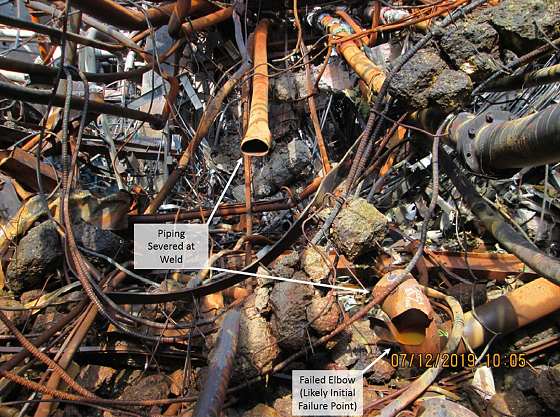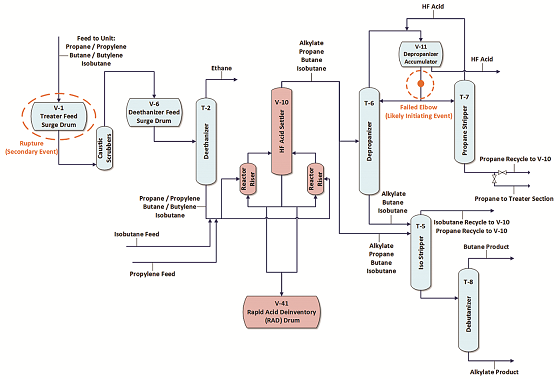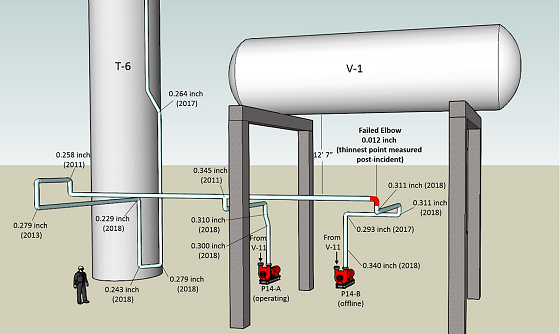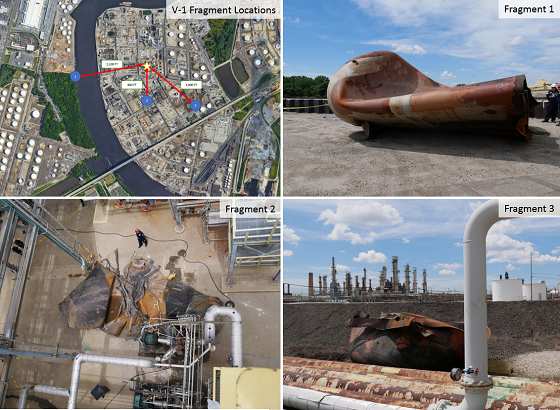Investigators with the U.S. Chemical Safety Board (CSB) (Washington, DC, USA) say a June 2019 explosion and fire at the Philadelphia Energy Solutions (PES) refinery in Philadelphia, Pennsylvania, USA, occurred due to a corroded pipe elbow in the refinery’s alkylation unit.
The factual update released in October 20191 notes that a pipe elbow, which had corroded to about half the thickness of a credit card, appears to have ruptured in the alkylation unit on the morning of June 21, 2019. That led to a process fluid release with more than 5,000 lb (2,268 kg) of hydrofluoric acid (HF), which formed a ground-hugging vapor cloud. Two minutes later, the cloud ignited, causing a massive fire and explosions.
“Since 2015, the CSB has investigated three major incidents at refineries that utilize HF for alkylation,” says Kristen Kulinowski, interim executive with the CSB. “Incidents in Superior, Wisconsin, and Torrance, California, fortunately did not result in an HF release. That was not the case here in Philadelphia. Though the main tank holding HF was not breached, HF was a component of the process fluid released from the alkylation unit. We are lucky there were no serious injuries or fatalities.”
Five workers experienced minor injuries during the incident and response, requiring first aid treatment. The CSB says it is currently unaware of any offsite or on-site health impacts from the HF release. The fire was completely extinguished by the next day.
Factual Update
While the CSB’s investigation is still ongoing, the factual update notes important details of the incident collected through interviewing witnesses, gathering evidence, and piecing together events that led to the explosion. According to investigators, the piping was susceptible to corrosion from the HF. The ruptured elbow corroded faster than the rest of the piping in this part of the process.

Though pipe thickness in that section of the unit was periodically measured to monitor corrosion rates, the thickness of the elbow that failed had not been monitored for corrosion, according to the CSB. In tests following the incident, the piece of piping that failed had a high nickel (Ni) and copper (Cu) content. Many industry publications have found that carbon steel with a higher percentage of Ni and Cu corrodes at a faster rate than carbon steel with a lower percentage when used in a process with HF, the investigators explain.

The elbow was part of the piping between V-11, the depropanizer accumulator at the refinery, and T-6, the depropanizer distillation column. The elbow was on the discharge outlet piping from a pump (one of two pumps in the system) that was not operating at the time of the incident. At the time of the event, this piping was operating at a pressure of about 380 psig (2.62 MPa) and a temperature of about 100 °F (37.8 °C). The approximate design composition of process fluid in the piping was 94.7% propane, 2.5% HF, and 2.8% additional hydrocarbons.
The piping circuit with the ruptured elbow was subject to regular ultrasonic thickness measurements at designated condition monitoring locations (CMLs) as part of the site’s inspection program to monitor the rate of piping metal loss due to corrosion. The most recent CML measurements did not indicate thin pipe. However, a CML was not located on the ruptured elbow, so the thickness of that elbow was not monitored. The thinnest measurement taken of the ruptured elbow after the incident was 0.012 in (0.30 mm), which is less than 7% of the PES default retirement thickness.

The elbow was part of the piping between V-11, the depropanizer accumulator at the refinery, and T-6, the depropanizer distillation column. The elbow was on the discharge outlet piping from a pump (one of two pumps in the system) that was not operating at the time of the incident. At the time of the event, this piping was operating at a pressure of about 380 psig (2.62 MPa) and a temperature of about 100 °F (37.8 °C). The approximate design composition of process fluid in the piping was 94.7% propane, 2.5% HF, and 2.8% additional hydrocarbons.
Not a New Issue
“Corrosion is not a new issue for the CSB,” says Lauren Grim, supervisory investigator with the CSB. “In its prior investigation of a 2012 Chevron refinery fire, we determined that corrosion caused the rupture of a piping component. Similarly, the 2009 Silver Eagle refinery fire was also caused by the failure of piping that had thinned due to corrosion.” The CSB is an independent, non-regulatory federal agency whose stated mission is to drive chemical safety change through independent investigations to protect people and the environment. The agency’s board members are appointed by the U.S. president and confirmed by the Senate. Their investigations look into all aspects of chemical incidents, including physical causes, such as equipment failure, as well as inadequacies in regulations, industry standards, and safety management systems.
According to the CSB, the piping circuit at the PES refinery containing the ruptured elbow was installed in about 1973, and it appears to be the site’s original piping. Both the elbow that failed and the adjacent elbow are stamped “WPB,” indicating that they were constructed to meet ASTM A2342 WPB material specifications. The 1965 version of ASTM A234 Standard Specification for Factory-Made Wrought Carbon Steel and Ferritic Alloy Steel Welding Fittings, the applicable version at the time of the pipe installation, required the WPB pipe “permissible raw materials” composition to meet the A1063 Grade B chemical composition specifications. At the time, the 1972 ASTM A106 standard did not specify Ni and Cu requirements.
In 1995, however, ASTM A234 began specifying Ni and Cu composition, as well as compositions of other elements. According to investigators, the Ni and Cu content of the ruptured elbow exceeded the updated A234 WPB requirements. The exact figures can be found in the CSB’s factual update1, which also includes an interim animation detailing all events.
Final Figures
Minutes after the initial fire and explosions, a secondary event at the PES refinery occurred when the V-1 Treater Feed Surge Drum ruptured, which launched a fragment of the vessel weighing 38,000 lb (17,236.5 kg) across the Schuylkill River. Two other large fragments of approximately 23,000 lb (10,432.6 kg) and 15,500 lb (7,030.8 kg) landed within the refinery itself. The drum contained primarily butylene, isobutane, and butane.
Following the incidents, PES hired a specialist in chemically cleaning alkylation units to develop a process to neutralize the HF contained in the drum. According to the CSB, neutralization is the process of reacting an acid with a base chemical with a high pH to produce water and a salt. Additional neutralization and de-inventory activities of other equipment in the unit are ongoing.

In all, PES estimates that about 676,000 lb (306,628.4 kg) of hydrocarbons were released during the event, of which approximately 608,000 lb (275,784.2 kg) were combusted. Low-concentration HF was also present in some of the process piping and equipment that failed during the incident, causing HF to release into the atmosphere. Of the HF release, PES estimates that 1,968 lb (892.7 kg) was contained by water spray within the unit and processed by the refinery wastewater treatment plant, while 3,271 lb (1,483.7 kg) was released into the atmosphere and not contained by water.
On June 26, PES announced that the refining complex would be shutting down. On July 22, PES filed for bankruptcy.
Moving forward, Kulinowski says the CSB is examining the need for more robust reviews of corrosion mechanisms, as well as looking more closely at the use of HF in the refining process. In the PES case, the CSB cautions that its investigation is ongoing. At the investigation’s conclusion, the CSB says it will publish a final report with findings and analysis, along with issuing recommendations.
Source: U.S. Chemical Safety Board, www.csb.gov.
References
1 “Chemical Safety Board Releases Factual Update and New Animation Detailing the Events of the Massive Explosion and Fire at the PES Refinery in Philadelphia, PA,” CSB News Releases, Oct. 16, 2019, https://www.csb.gov/chemical-safety-board-releases-factual-update-and-new-animation-detailing-the-events-of-the-massive-explosion-and-fire-at-the-pes-refinery-in-philadelphia-pa/ (Nov. 4, 2019).
2 ASTM A234, “Standard Specification for Piping Fittings of Wrought Carbon Steel and Alloy Steel for Moderate and High-Temperature Service” (West Conshohocken, PA: ASTM International, 2018).
3 ASTM A106, “Standard Specification for Seamless Carbon Steel Pipe for High-Temperature Service” (West Conshohocken, PA: ASTM International, 2018).